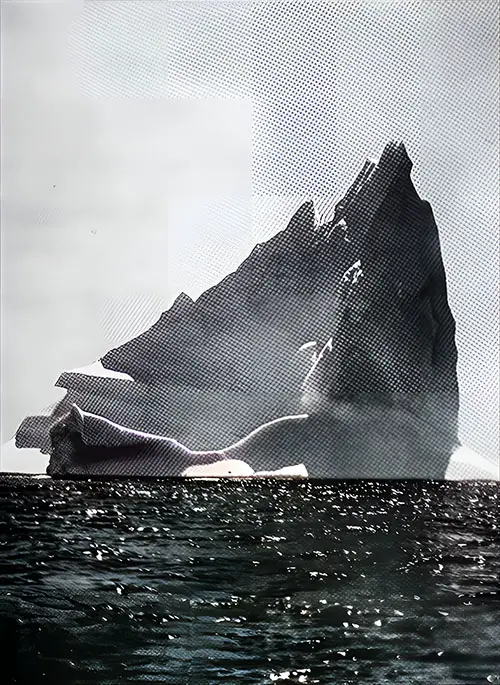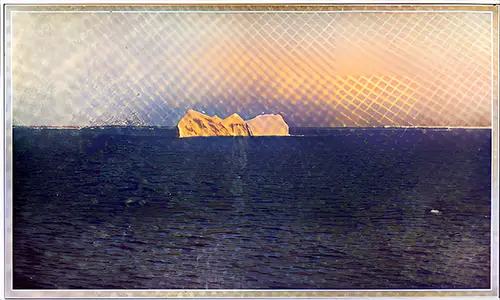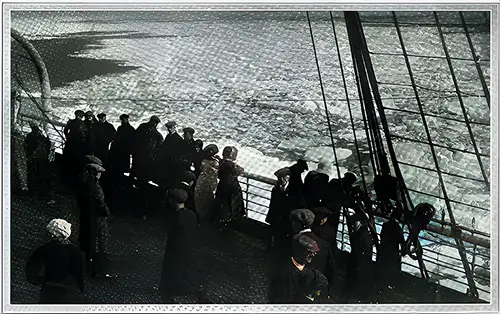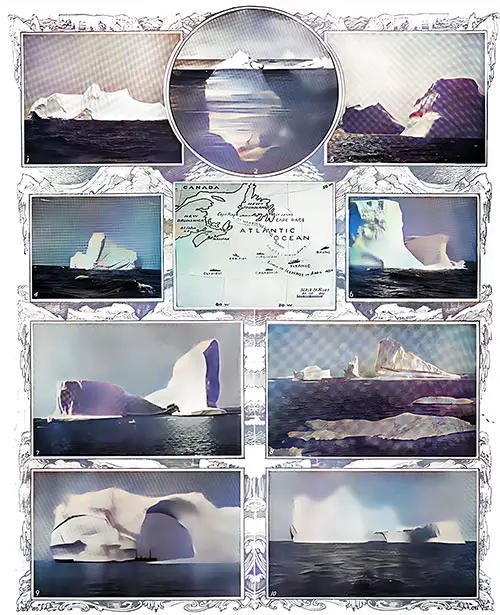Ice in the Sea Lanes Sailed by the Titanic - 1912

A Ship Might Just as Well Strike a Rock: A Giant Iceberg, Akin to That Which Caused the Sinking of the RMS Titanic. The Illustrated London News (4 May 1912) p. 633. GGA Image ID # 1011862e22
Introduction
The tragic sinking of the RMS Titanic on April 14, 1912, after colliding with an iceberg has served as a powerful reminder of the dangers lurking in the North Atlantic's icy waters. The article "Ice in the Sea Lanes Sailed by the Titanic - 1912" offers a detailed exploration of the natural hazard that icebergs represent to ocean liners navigating these sea lanes. The piece discusses the presence of icebergs, or "white foes," in the shipping routes, the unpredictability of their movements, and the severe impact they have on maritime safety. Insights from experts, including Dr. H.R. Mill, and the observations of various ship captains underscore the immense challenge that icebergs present. The article also touches on the discussions that took place among Titanic's officers about the risks posed by ice and the subsequent changes in sea routes to improve safety. This exploration underscores the significance of understanding and mitigating the iceberg threat in ensuring safer transatlantic voyages.
Dr. H. R. Mill, interviewed by the "Chronicle "after the "Titanic" disaster, said: "A certain amount of help in detecting the approach of icebergs is given by observing the temperature of the sea.
As a rule, the sea-water temperatures are taken at intervals of two hours on the ordinary Transatlantic steamers. However, such gaps are of comparatively little value in providing a warning with a high-speed vessel.
I am not aware whether temperature observations are taken very frequently on these fast steamers, but it would be obvious prevention to do so.
These icebergs are usually comparatively small in terms of area. Still, they are of great height and extend to an enormous depth below the water to have tremendous momentum. A ship might just as well strike a rock."
The White Foe: Ice in the Sea-Lane Sailed by the "Titanic."

Akin to That Which Gave the RMS Titanic Her Death-Blow: An Iceberg. Which Was Likely Part of the Ice-Field Encountered by the Ill-Fated Vessel. Photographed from the SS Tunisian a Few Days before the Disaster. The Illustrated London News (11 May 1912) p. 699. © Illustrations Bureau. GGA Image ID # 1012190da2

In the Neighbourhood of the RMS Titanic's Collision with an Iceberg: Passengers on a Steamer Looking at an Ice-Field. The Illustrated London News (11 May 1912) p. 699. © Fridoline. GGA Image ID # 1012220fab
It is a matter of common knowledge that the RMS Titanic's fate was sealed by an encounter with an iceberg. In the face of this natural hazard, it is only fitting to acknowledge the bravery and resilience of the ship's officers, who undoubtedly had numerous discussions about the ice in the sea lane she followed.
In the earliest stage of the Senatorial Inquiry, Mr. Bruce Ismay said. "We were on the southern route, "the extreme southern route," and, further. "It is absolutely and unqualifiedly false that I ever said that I wished that the Titanic should make a speed record or increase her daily runs.
As I have already testified, I deny having said to anyone that we would increase our speed to act out of the ice zone or any words to that effect. At no time did the Titanic attain her full speed during the voyage."
Ice drifts in the North Atlantic are a great menace to shipping, and the question is: Is there a track outside the ice limit that Transatlantic liners can take?
The answer would seem to be "No." Acting beyond even the average, as opposed to the abnormal limit, would mean an impossibly wide detour south and an impossibly significant loss of time.
Following the disaster and considering the unusual ice position that year, a decision was made, a decision that was not only necessary but also very wise. It was decided to alter the track of several vessels, a move that undoubtedly reassured many about the commitment to future safety measures.

In the Sea-Lane, the "Titanic" Sailed: Icebergs off Newfoundland. The Illustrated London News (4 May 1912) p. 660. Photographs by Holloway; Map by Courtesy of the "Daily Mail." GGA Image ID # 1012a8fccc
Images, Top to Bottom, Left to Right:
- From the Foot of an Arctic Glacier: An Iceberg off St. John's. Newfoundland.
- Eight-Ninths of It Submerged; How an Iceberg Floats.
- Result of a Land Glacier Calving: An Iceberg off St. John's. Newfoundland.
- A Grave Menace to Shipping: An Iceberg on the High Seas.
- The Scene of the Disaster to the "Titanic": The Field. Ice and Iceberg Limits and the Approximate Positions of Various Vessels.
- Weathered by Sun and Rain: An Iceberg off the Entrance to St. Johns Harbour.
- Off the Labrador Coast: A Great Berg.
- Off the Labrador Coast: Floating Ice.
- With a Steamship beneath Its Great Arch: A Huge Berg.
- With an Arch: An Iceberg Photographed off ST. John's, Newfoundland.
"The great bergs broke off the feet of Arctic glaciers and floating south in the Arctic current till they meet the Gulf Stream are not commonly expected to cross the path of Transatlantic travel before summer, and it may be that the icebergs now reported off Newfoundland are the Laggards of last year's crop, entangled and frozen up in the flow."
We quote the "Times," which continues: "At any rate, a great ice field with many icebergs has been obstructing the Westbound Transatlantic sea lane off the Newfoundland Grand Banks for the past week. Ships' captains estimate its length to be 70 miles, with a breadth of 35 miles.
Mr. J. H. Welsford, the Liverpool shipowner who traveled on board the SS Carmania… stated that he had never seen the ice so far south as on his last voyage and in such great bulk.
There were numerous 'growlers '—large icebergs that had melted on top until their upper surfaces were almost awash—and bad or failing light was challenging to discern.
The RMS Titanic sank after a collision with an iceberg between Sable Island, Nova Scotia, and Cape Race, Newfoundland. She was fourteen miles south of the possible range of ice fields when the disaster occurred.
Bibliography
"'A Ship Might Just as Well Strike A Rock': A Giant Iceberg. Akin to That Which Caused The Sinking of the Titanic," in The Illustrated London News, New York: The International News Company, Vol. 50, No. 1304, 4 May 1912: 633.
"In the Sea Lane the 'Titanic' Sailed: Icebergs Off Newfoundland," in The Illustrated London News, New York: The International News Company, Vol. 50, No. 1304, 4 May 1912:660.
"The White Foe: Ice in the Sea Lane Sailed by the 'Titanic,'" in The Illustrated London News, New York: The International News Company, Vol. 50, No. 1305, 11 May 1912:699.
Key Points
-
The Perils of Icebergs in Transatlantic Sea Lanes:
- Icebergs pose a severe hazard to ships traversing the North Atlantic, especially during the spring and early summer months when icebergs from the Arctic glaciers drift southward into transatlantic shipping lanes.
- The article describes icebergs as being potentially as dangerous as rocks, given their immense size and the vast portion that remains submerged, making them difficult to detect and avoid. The Titanic's collision with one such iceberg was akin to striking a rock.
-
Expert Opinions on Iceberg Detection and Navigation:
- Dr. H.R. Mill, interviewed after the Titanic disaster, discussed the limitations of using sea temperature readings to detect icebergs. While periodic temperature checks could provide some warning, they were insufficient for fast-moving vessels like the Titanic.
- The article highlights the inherent difficulties in detecting icebergs, particularly those that have partially melted or are submerged just below the water surface, known as "growlers," which are nearly invisible even in good conditions.
-
Ice Conditions During the Titanic Disaster:
- The year of the Titanic disaster saw an unusual presence of icebergs farther south than typically expected. An expansive ice field, stretching 70 miles long and 35 miles wide, obstructed the westbound transatlantic sea lane off the Grand Banks of Newfoundland.
- This abnormal ice presence resulted from a combination of the Arctic current bringing icebergs southward and their subsequent entanglement in the Gulf Stream. The unusual convergence of these currents created conditions ripe for disaster.
-
Eyewitness Accounts and Observations of Ice:
- The article includes reports from passengers and captains who encountered large ice fields and "growlers" during their voyages, particularly in the weeks surrounding the Titanic's sinking. These firsthand accounts emphasize the treacherous nature of navigating iceberg-laden waters.
- Mr. J. H. Welsford, a Liverpool shipowner traveling on the SS Carmania, noted that he had never seen such extensive ice so far south, underscoring the abnormal conditions that year.
-
Discussions Among the Titanic's Officers:
- The Titanic's officers were aware of the dangers posed by icebergs and likely discussed them extensively during the voyage. The article quotes Mr. Bruce Ismay, who testified during the Senatorial Inquiry that the Titanic was on its "extreme southern route" and had not been speeding to break any records, contrary to some accusations.
-
Post-Disaster Route Adjustments and Safety Measures:
- In response to the disaster and the abnormal ice conditions of that year, shipping companies decided to alter their sea routes to avoid the regions most likely to contain ice. This change demonstrated a heightened commitment to passenger safety and a more cautious approach to transatlantic navigation.
Summary
The article "Ice in the Sea Lanes Sailed by the Titanic - 1912" provides an in-depth examination of the iceberg threat in the North Atlantic shipping lanes and the challenges they pose to ocean liners like the Titanic. It highlights the dangers of icebergs, which are as perilous as rocks, and the limited methods available at the time for their detection, especially for fast-moving vessels. The unusual ice conditions in 1912 contributed to the Titanic's tragic encounter with an iceberg, prompting subsequent adjustments in sea routes and navigation practices to enhance safety. Expert opinions and eyewitness accounts underscore the unpredictable nature of iceberg movements and the need for more effective warning systems and navigational precautions. The article illustrates the ongoing struggle between human ingenuity and natural forces and the lessons learned from the Titanic's fateful voyage.
Conclusion
The sinking of the RMS Titanic remains one of the most significant maritime tragedies in history, and the presence of icebergs in the North Atlantic sea lanes played a central role in this disaster. As the article "Ice in the Sea Lanes Sailed by the Titanic - 1912" reveals, the threat posed by these "white foes" is both substantial and unpredictable, requiring constant vigilance and adaptation from those who navigate these waters. The disaster underscored the need for improved detection methods, better-informed navigation practices, and the willingness to adjust sea routes in response to environmental conditions. The changes implemented after the Titanic's sinking, including altered routes and more cautious navigation, reflect a more profound understanding of these risks and a commitment to preventing similar tragedies in the future. The story of the Titanic and the ice that sealed its fate is a powerful reminder of the limits of human control over nature and the importance of respecting the formidable power of the sea.
